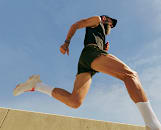
Golser via Getty Images
How to Enjoy Running On the Beach, According to Pros
Running on sand might be just the challenge your body needs.
By Jennifer Heimlich•
The Benefits of Running On the Beach
Potential Downsides of Beach Running
6 Tips for Running On the Beach
Should You Wear Shoes When Running on Sand?
The Takeaway
From the opening scene of Chariots of Fire to the iconic slow-mo shots in Baywatch, running on the beach is a classic cinematic trope. Yet, for as freeing as it might look on film, in reality, running on sand can be surprisingly difficult—which is precisely what makes it a great workout. To take advantage of beach running, you just need to be strategic to stay safe and actually enjoy the experience. Here’s what pros suggest keeping in mind the next time you find yourself looking to pull off some picturesque strides along the sea.
Discover more ways to reach your goals with Peloton
The Benefits of Running On the Beach
What Peloton instructor Becs Gentry loves most about running on the beach is “the challenge it gives the body—muscular and cardio!” she says. The unstable surface works certain muscles overtime, particularly the intrinsic foot muscles (the muscles inside your feet), the calves, and the deep hip stabilizers, according to physical therapist Lyssa Cleary, co-owner of Athletic Lab Physical Therapy and Performance Training.
Running on sand also gets your heart majorly pumping. Unlike the road, where you have a rigid surface to push off of and propel your body forward, sand slips under your foot, so you get less forward motion out of each stride. “And that means you have to use more force and more muscle engagement to generate the same speed,” Cleary says.
In many ways, this is helpful largely because it’s just different. “Running, by nature, is such a repetitive sport—it’s in one direction, [striding] over and over again,” Cleary says. By running on the sand, you’re changing up the training stimulus, she says, which is almost always good for training, but especially in a sport that’s so repetitive.
Plus, you can’t discount the view. Cleary points out that many people run for stress relief, and running on the beach is a great way to lean into that. Research has shown that exposure to “blue spaces” (outdoor environments that prominently feature water, such as the beach) can positively affect mental health and well-being.
Potential Downsides of Beach Running
There’s no way around it: Running on sand is far harder than running on solid ground. If you’re trying to keep your heart rate in check during a run on the beach, you’re going to have to slow way down.
Because the surface is so shifty and varied, running on sand can be especially tough for anyone with lower leg weakness. “Beach running requires more of the foot and ankle muscles, and a lot of times people aren’t prepared for that,” Cleary says. “It can increase the risk for injury at the foot and ankle, and overload those tendons, especially the Achilles tendon.” If you’re already struggling with a lower leg or foot injury, you might want to skip beach running altogether, since it could put too much stress on tissues that are trying to heal.
6 Tips for Running On the Beach
A beach run can be wonderful—or a major struggle. To make sure you enjoy the experience while maximizing the perks, keep these tips in mind.
1. Start Small
Even if you’re an advanced runner, the beach is not a great location for a long run (unless you’re already very used to running on sand). “Start short—it is very tiring,” Becs says. “You will feel this.”
If you want to make beach runs a regular part of your training, Cleary suggests working up to it slowly. “Just like you would build up for a training program, I would build up to running on the beach,” she says. “Go for walks on the beach and recruit those muscles first, and then start to add in some running.” Remember: You can always plan part of your run on the road and just a mile or two on the sand until your body gets used to the challenge.
2. Maintain Your Form
Running on sand feels quite different from running on roads. But you don’t want to intentionally change anything about your running technique—you still want to run with the same proper running form, Becs says. Just know that your core, and especially your obliques (the muscles on the sides of your torso), might fire up in a way that feels different from a typical run, she adds.
3. Slow Down
Because running on sand is so much harder, be prepared for your speed to take a hit, Becs says. In fact, Cleary recommends ignoring your pace altogether and instead running based on your rate of perceived exertion (or RPE), typically measured on a scale of 0 to 10. “If your rate of perceived exertion is typically around 5 out of 10 on the road, keep that 5 out of 10 on the beach,” she says. “Be less focused on your speed and more focused on how it feels.” This will reduce your risk for overload and injury—and help you actually enjoy the run.
4. Choose Your Sand Strategically
Becs says that when she does a beach run, she gravitates to the harder, more compact wet sand by the water’s edge. “This can often be the most stable underfoot,” she says. “Especially if you’re new to sand running, it might leave your legs a little less fatigued.” Because it’s a bit easier to generate the forces that propel you forward, this will feel closer to running on a road, Cleary adds.
Just be aware that there’s often a bit of slant to the sand right next to the water. “That can stress the sides of the body differently because the leg closer to the water is going to have a longer way to go before it hits the ground,” Cleary says. You’ll want to do an out-and-back run going in both directions so you even out the stresses on the body.
On the other hand, running on the dry, soft sand further away from the water will amp up the challenge. But this will also usually be flatter, which is safer for someone with an injury like IT band syndrome or inner knee pain, Cleary says.
Related Articles
5. Protect Your Skin
You’re probably not going to find any shade during a beach run. “Take care of one of the most important organs in your body—your skin,” Cleary says. Wear a hat, sweat-resistant sunscreen, and UV-protective clothing.
6. Embrace Your Surroundings
There’s a reason you chose to run on the beach, so soak it up. Even if you typically like tuning out to music or a podcast, consider unplugging at the beach to pay attention to the sound of the waves and the seagulls, and breathe in the smell of the saltwater. “Use it as a time to be present with yourself and your surroundings,” Cleary suggests. Also, consider the ultimate pro move: “Finish in the ocean!” Becs says.

Jordi Salas/Moment via Getty Images
Should You Wear Shoes When Running on Sand?
Whether or not you wear shoes when running on sand is largely a personal preference.
“Running barefoot is very freeing and can help train underused muscles in our feet,” Becs says. However, it can be too challenging for some runners’ feet, so wearing shoes can help ease some of the stress on those muscles, according to Cleary. And sneakers give you the option to easily hop onto some pavement nearby if you’re struggling on the sand, Becs adds.
Your location can also dictate your choice. “Some sand can be sharp and cold, so shoes would be best,” Becs says.
If you do decide to don shoes while running on the beach, just remember to wear high socks inside of them to keep the sand out. “Sand in your socks can rub and cause blisters,” Becs warns.
The Takeaway
Running on the beach can be challenging, thanks to the unstable surface that sand gives us. But it’s a fun, healthy way to mix up your running routine, and can be a good time to practice just enjoying the sport without getting too wrapped up in the metrics on your smartwatch. “Don’t be tied to what your speed is, what the distance is that you’re going,” Cleary says. “Just use it as a way to enjoy the outdoors, enjoy something that you love to do in a bit of a different way.”

Peloton App
Access thousands of classes with no equipment needed.
This content is for informational and educational purposes only and does not constitute individualized advice. It is not intended to replace professional medical evaluation, diagnosis, or treatment. Seek the advice of your physician for questions you may have regarding your health or a medical condition. If you are having a medical emergency, call your physician or 911 immediately.
Level up your inbox.
Subscribe for a weekly dose of fitness, plus the latest promos, launches, and events.
By providing your email address, you agree to receive marketing communications from Peloton.
For more about how we use your information, see our Privacy Policy.














